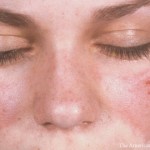Using these data, the investigators calculated that a EULAR/ACR SLE score of 20 was optimal for use as a threshold to compare demographic, clinical characteristics and outcomes between groups.
The team then applied that threshold and analyzed the data. At baseline, patients who presented with a score higher than 20 were younger than those who had lower scores (34.5 vs. 38.1 years old; P≤0.001), and they had a higher SLE Disease Activity Index 2000 (SLEDAI-2K) score than those who had lower EULAR/ACR SLE scores. When the researchers analyzed cumulative medication doses, they found patients with a EULAR/ACR SLE score of 20 or more required more aggressive therapy with glucocorticoids and immunosuppressive therapy than those who had a score of less than 20. Specifically, patients with a score of 20 or more had greater cumulative and mean daily doses of glucocorticoids during the first one, three and five years of disease course than those who had a score of less than 20.
Beyond Lupus Nephritis
Patients with a EULAR/ACR SLE score of 20 or more had greater number of organ system involvements than did patients with a score of less than 20. The exceptions to this finding were autoimmune hemolysis, psychosis, subacute cutaneous and discoid rash, which were evenly distributed between groups. Additionally, the investigators found patients with a EULAR/ACR SLE score of 20 or more had higher adjusted mean SLE Disease Activity Index 2000 scores over the first one, three and five years than did patients with a score less than 20. At baseline, age also correlated with SLE Disease Activity Index 2000 at three and five years.
Dr. Johnson expressed surprise that the study revealed patients with a EULAR/ACR SLE score of 20 or more were more likely to present with flares than those with a score of less than 20 (P<0.001), in general, and renal and hematological flares, specifically. After adjusting for ethnicity and age at baseline, the researchers found that every 10-point increase in EULAR/ACR SLE score increased the risk of a flare by 22.5%. However, the authors did not find a correlation between EULAR/ACR SLE score at baseline and damage at five years after diagnosis.
The investigators considered four different definitions of remission: 1) complete remission (i.e., no clinical and serological disease activity as determined by SLEDAI-2K score=0) off treatment, 2) clinical remission (i.e., serologically active clinical quiescent disease described as clinical SLEDAI-2K score=0, high anti-dsDNA antibodies and/or declining C3 level) off treatment, 3) complete remission on treatment and 4) clinical remission on treatment. They found that, during any given timeframe, patients with a EULAR/ACR SLE score of 20 or more were less likely to achieve remission than those with a score less than 20. Individuals with a score of 20 or more had at least a 15% lower probability of achieving remission than individuals with a score of less than 20.


